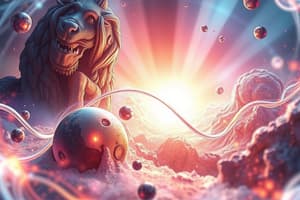Podcast
Questions and Answers
What is the relationship between the equilibrium constant Kp and Kc?
What is the relationship between the equilibrium constant Kp and Kc?
- Kp = Kc / (RT)∆n
- Kp = Kc (RT)∆n (correct)
- Kp = Kc + (RT)∆n
- Kp = Kc - (RT)∆n
What does a value of K >> 1 indicate about the reaction?
What does a value of K >> 1 indicate about the reaction?
- The reaction is irreversible
- The reaction is at equilibrium
- The reaction is product-favored (correct)
- The reaction is reactant-favored
Why does the equilibrium constant remain the same regardless of the initial concentrations of reactants and products?
Why does the equilibrium constant remain the same regardless of the initial concentrations of reactants and products?
- Because the reaction is at a fixed temperature
- Because the equilibrium constant is a ratio of concentrations (correct)
- Because the reaction is reversible
- Because the reaction rate is independent of concentration
What is the significance of ∆n in the equation Kp = Kc (RT)∆n?
What is the significance of ∆n in the equation Kp = Kc (RT)∆n?
What happens to the equilibrium when K < 1?
What happens to the equilibrium when K < 1?
What is the implication of the equilibrium constant being the same regardless of the direction of the reaction?
What is the implication of the equilibrium constant being the same regardless of the direction of the reaction?
What is the condition for a system to be in chemical equilibrium?
What is the condition for a system to be in chemical equilibrium?
What is the relationship between the rate constants kf and kr at equilibrium?
What is the relationship between the rate constants kf and kr at equilibrium?
What is the equilibrium expression for the reaction aA + bB cC + dD?
What is the equilibrium expression for the reaction aA + bB cC + dD?
What is the purpose of the double arrow in a chemical equation at equilibrium?
What is the purpose of the double arrow in a chemical equation at equilibrium?
What is the relationship between the equilibrium constants Kc and Kp?
What is the relationship between the equilibrium constants Kc and Kp?
What is the rate law for the forward reaction N2O4 (g) 2 NO2 (g)?
What is the rate law for the forward reaction N2O4 (g) 2 NO2 (g)?
When a system at equilibrium is disturbed by a change in temperature or pressure, what happens to the equilibrium position?
When a system at equilibrium is disturbed by a change in temperature or pressure, what happens to the equilibrium position?
What is the effect of adding more of a reactant to a system in equilibrium?
What is the effect of adding more of a reactant to a system in equilibrium?
What is the purpose of removing ammonia (NH3) from the system in the Haber Process?
What is the purpose of removing ammonia (NH3) from the system in the Haber Process?
What is the effect of a catalyst on a system in equilibrium?
What is the effect of a catalyst on a system in equilibrium?
What happens to the equilibrium constant (K) when the temperature of a system is increased?
What happens to the equilibrium constant (K) when the temperature of a system is increased?
What is the relationship between the equilibrium constant (K) and the rate of the forward reaction?
What is the relationship between the equilibrium constant (K) and the rate of the forward reaction?
Flashcards are hidden until you start studying




